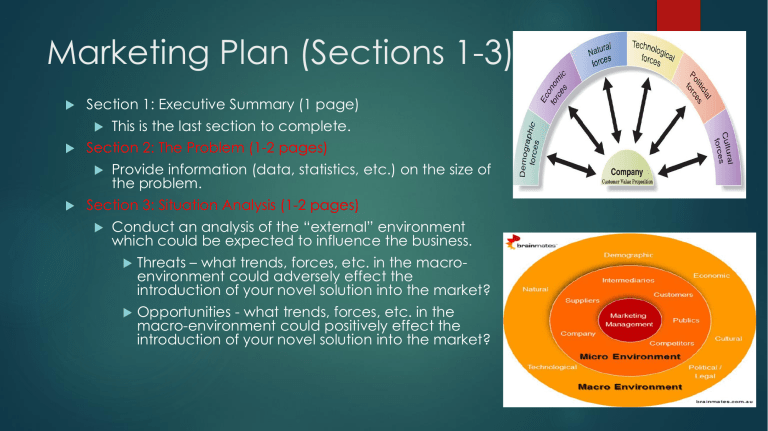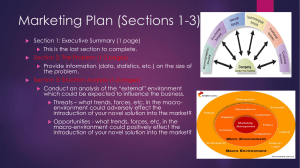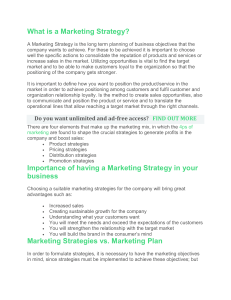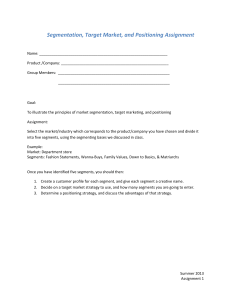
Marketing Plan (Sections 1-3) Section 1: Executive Summary (1 page) Section 2: The Problem (1-2 pages) This is the last section to complete. Provide information (data, statistics, etc.) on the size of the problem. Section 3: Situation Analysis (1-2 pages) Conduct an analysis of the “external” environment which could be expected to influence the business. Threats – what trends, forces, etc. in the macroenvironment could adversely effect the introduction of your novel solution into the market? Opportunities - what trends, forces, etc. in the macro-environment could positively effect the introduction of your novel solution into the market? Marketing Plan (Sections 4-6) Section 4: Market Segmentation (2-3 pages) Identify distinct groups of possible customers. ALL PLANS should include at least one B2B and one B2C. Maximum # of segments is 5. For each segment identified – provide a catchy, memorable name for the segment. Claritas provides a list of 68 recognized segments in the U.S. Note how the company uses a combination of demographic, psychographic, geographic and behavioral characteristics. https://claritas360.claritas.com/mybestsegments/#segDetails B2B: Describe these segments based on characteristics of the company AND/OR decision maker(s). Firmographics include industry (NAICS codes), company size, locations, types of products/services they produce. What is the job title of those who make purchase decisions for the company? What are their motives and behaviors? The following website and article is an excellent source of information for B2B segmentation https://sopro.io/added-value/blog/b2b-market-segmentation-guide/ Section 5: Targeting (1 page) B2C: Describe these segments using demographic, psychographic, geographic, and behavioral characteristics. Defend the selection of one segment to target utilizing evidence related to profitability. Strategic fit is also a criteria existing companies use when selecting a target market. But, since this plan is fictitious, we’ll just use profitability as the criteria for selecting a target segment. Profitability: Sure…the size of the segment matters (the larger the better). But, “willingness to pay”, segment growth, and which segment will value the concept the most are better indicators of the most profitable segment. In some cases, for B2B, it may be that your product/service helps to SAVE them money (which is also a profitability argument) or it helps them to differentiate from competitors. Section 6: Positioning (1-2 pages) Provide a positioning statement…a concise description of your target market as well as a compelling picture of how you want that market to perceive your brand. For the first (and only) time in the plan – discuss competitors. Who are the current competitors or alternatives (substitutes) in the market? What makes them unique? What is your unique selling proposition? What are the Points of Differentiation? How will your product/service be different from competitors/substitutes in the market? The following article provides 3 keys to successful positioning and 7 distinct positioning strategies. https://www.indeed.com/career-advice/career-development/positioning-strategy Marketing Plan: Section 7 Revenue Streams, Product Attributes (1-2 pages) Section 7.1 – What is the PRIMARY business model (i.e. how you’ll generate revenue)? What additional revenue streams may be developed? Section 7.2 – Describe the features, services, attributes for the concept. Remind the reader of the “unique” offerings described in Section 6 (Positioning). Section 7.3 – Non-product Attributes (Packaging, Labeling, Warranties, Certifications, etc.) Does it require customers to sign-up or become a “member”? What information must be collected from the customer? Is a warranty or guarantee typical for such a product (for example, a return policy)? If so, what are the common features of such a warranty? Does it require a warning label? What must be listed on the label? How will the product be packaged? Is there anything distinct about the packaging? What types of customer service are required before and after the sale? How is that service delivered? Provide a drawing or other depiction for a prototype of the product/service. If an “app” provide a visual depiction of the interface customers would use. Marketing Plan: Section 8 Distribution/ Place (2-3 pages) Section 8.1 – Partners, Suppliers and Manufacturers Think of this section as everything needed to DEVELOP/ PRODUCE the concept. What partners or third-party vendors are needed (for example, software/ app developers, engineers, consultants)? What raw materials are necessary and which companies are the best manufacturers to work with? The plan should include the names of real suppliers/partners where possible. Also include a very brief explanation for why this supplier/partner is the best option. Section 8.2 – Distributors, Retailers or Direct to Consumer Think of this section as everything needed to DELIVER the concept. Why is this the best distribution channel for the target market? The best marketing plans will mention at least one alternative channel considered…and then explain why the channel proposed is the best given the target market. Provide data to support the selection of the distribution channel. If selling direct to consumers, what additional partners are necessary to do so (website developers, shipping partners)? Which partners are best? Explain. If the channel involves retailers, what is the BEST retail option? Explain why this retailer is better than other options. (same questions for a channel which requires distributors) Will you need a sales force? What training is necessary? What is the best way to organize the sales force (geography, “type of customer”, etc.)? Provide a graphical depiction of the distribution channel (see next slide for a simple example). Marketing Plan: Section 9 Pricing (1-2 pages) Section 9.1 – Fixed and Variable costs Provide a best estimate for the fixed costs necessary to produce the concept. Plant, Property and Equipment Salaries for key employees (including yourself) Provide a best estimate for the variable costs necessary to produce the concept. A best estimate for the cost of key inputs. The cost to download an app Section 9.2 - Introductory Price Range Propose BOTH a price ceiling and a price floor. How did you arrive at these estimates? Describe. See next slide for guidance Section 9.3 – Breakeven analysis What is the breakeven point for both the ceiling and floor price? Provide a spreadsheet summarizing the key fixed and variable cost estimates. Marketing Plan: Section 10 Promotion (2-3 pages) Section 10.1 – Brand Name and slogan/motto/tagline Explain the name for the branded concept and a brand slogan? The best name and slogan are 1) memorable and 2) reflect the positioning by communicating the key benefits for the target market. Section 10.2 – Public Relations - Identify a blogger, magazine, news outlet or other credible source capable of reviewing and commenting on the concept. Provide evidence to support the selection of this credible, third-party. Section 10.3 – Integrated Marketing Communications - Select NO MORE THAN 2 promotional opportunities which are best to reach the target market. Like every marketing mix decision in this plan…provide a short rationale for why these promotional options were chosen as opposed to others. Why are these the best way to communicate with the target market? TV ad (on what channel during what shows), Radio ads (on what stations during what shows), billboards or other signage (provide a specific location for such a sign), viral videos, newspaper/ magazines (including trade publications), trade shows, street/guerilla marketing, online ads (what site), mobile ads, product placement, direct mail, sponsorships, others? Provide examples of ad concepts (what would a billboard ad look like, online ad, a “story board” for a TV ad)?







